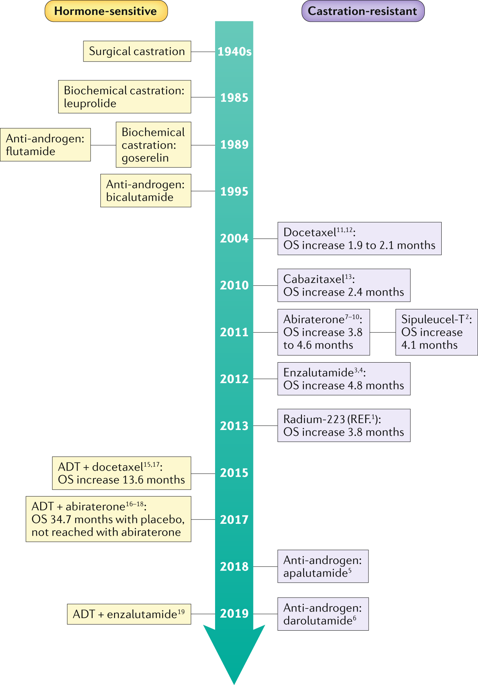当前位置:
X-MOL 学术
›
Nat. Rev. Urol.
›
论文详情
Our official English website, www.x-mol.net, welcomes your
feedback! (Note: you will need to create a separate account there.)
Cellular rewiring in lethal prostate cancer: the architect of drug resistance.
Nature Reviews Urology ( IF 12.1 ) Pub Date : 2020-03-16 , DOI: 10.1038/s41585-020-0298-8 Marc Carceles-Cordon 1 , W Kevin Kelly 1 , Leonard Gomella 2 , Karen E Knudsen 1, 2, 3 , Veronica Rodriguez-Bravo 3 , Josep Domingo-Domenech 1, 3
Nature Reviews Urology ( IF 12.1 ) Pub Date : 2020-03-16 , DOI: 10.1038/s41585-020-0298-8 Marc Carceles-Cordon 1 , W Kevin Kelly 1 , Leonard Gomella 2 , Karen E Knudsen 1, 2, 3 , Veronica Rodriguez-Bravo 3 , Josep Domingo-Domenech 1, 3
Affiliation

|
Over the past 5 years, the advent of combination therapeutic strategies has substantially reshaped the clinical management of patients with advanced prostate cancer. However, most of these combination regimens were developed empirically and, despite offering survival benefits, are not enough to halt disease progression. Thus, the development of effective therapeutic strategies that target the mechanisms involved in the acquisition of drug resistance and improve clinical trial design are an unmet clinical need. In this context, we hypothesize that the tumour engineers a dynamic response through the process of cellular rewiring, in which it adapts to the therapy used and develops mechanisms of drug resistance via downstream signalling of key regulatory cascades such as the androgen receptor, PI3K-AKT or GATA2-dependent pathways, as well as initiation of biological processes to revert tumour cells to undifferentiated aggressive states via phenotype switching towards a neuroendocrine phenotype or acquisition of stem-like properties. These dynamic responses are specific for each patient and could be responsible for treatment failure despite multi-target approaches. Understanding the common stages of these cellular rewiring mechanisms to gain a new perspective on the molecular underpinnings of drug resistance might help formulate novel combination therapeutic regimens.
中文翻译:

致命性前列腺癌中的细胞重新布线:耐药性的建筑师。
在过去的五年里,联合治疗策略的出现极大地改变了晚期前列腺癌患者的临床治疗。然而,大多数这些联合治疗方案都是根据经验开发的,尽管提供了生存益处,但不足以阻止疾病进展。因此,开发针对耐药性获得机制和改进临床试验设计的有效治疗策略是尚未得到满足的临床需求。在这种情况下,我们假设肿瘤通过细胞重新布线的过程产生动态反应,在这个过程中,它适应所使用的治疗方法,并通过关键调控级联的下游信号传导(例如雄激素受体、PI3K-AKT)形成耐药机制。或 GATA2 依赖性途径,以及启动生物过程,通过表型转变为神经内分泌表型或获得干细胞样特性,将肿瘤细胞恢复到未分化的侵袭状态。这些动态反应对于每个患者来说都是特定的,尽管采用多目标方法,但也可能导致治疗失败。了解这些细胞重连机制的共同阶段以获得耐药性分子基础的新视角可能有助于制定新的联合治疗方案。
更新日期:2020-03-16
中文翻译:

致命性前列腺癌中的细胞重新布线:耐药性的建筑师。
在过去的五年里,联合治疗策略的出现极大地改变了晚期前列腺癌患者的临床治疗。然而,大多数这些联合治疗方案都是根据经验开发的,尽管提供了生存益处,但不足以阻止疾病进展。因此,开发针对耐药性获得机制和改进临床试验设计的有效治疗策略是尚未得到满足的临床需求。在这种情况下,我们假设肿瘤通过细胞重新布线的过程产生动态反应,在这个过程中,它适应所使用的治疗方法,并通过关键调控级联的下游信号传导(例如雄激素受体、PI3K-AKT)形成耐药机制。或 GATA2 依赖性途径,以及启动生物过程,通过表型转变为神经内分泌表型或获得干细胞样特性,将肿瘤细胞恢复到未分化的侵袭状态。这些动态反应对于每个患者来说都是特定的,尽管采用多目标方法,但也可能导致治疗失败。了解这些细胞重连机制的共同阶段以获得耐药性分子基础的新视角可能有助于制定新的联合治疗方案。











































 京公网安备 11010802027423号
京公网安备 11010802027423号